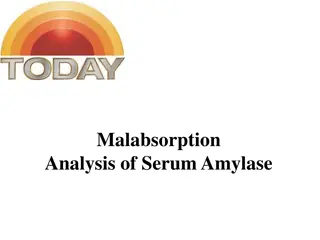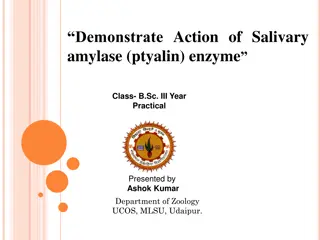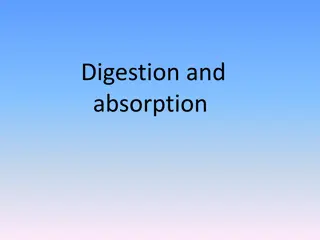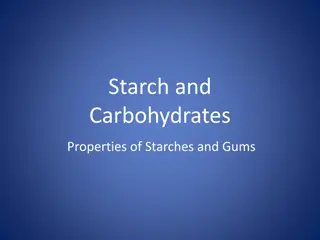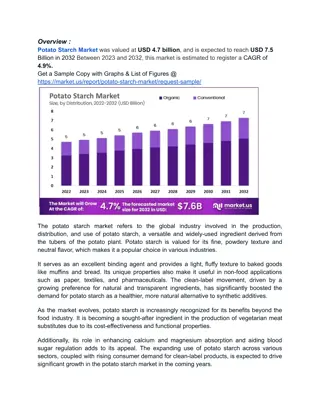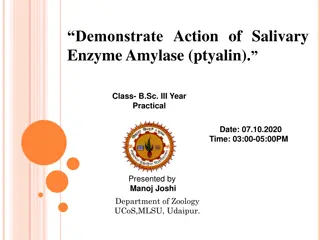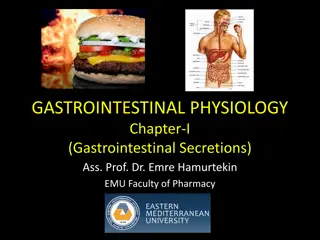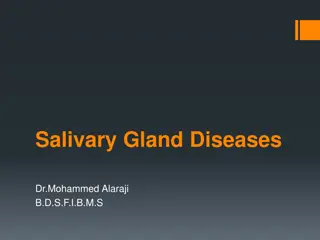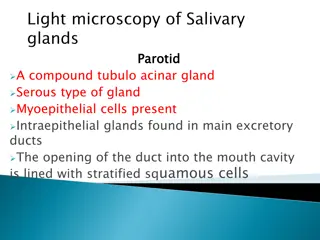The Hydrolytic Activity of Salivary Amylase on Starch
Enzymes play a crucial role in catalyzing chemical reactions in the human body. This experiment focuses on the hydrolytic activity of salivary amylase on starch, breaking down polysaccharides into intermediate products like maltose. The mechanism of amylase action, types of amylase, and the assay method for measuring reaction rates are explored. Enzyme activity is influenced by various factors like temperature, pH, and substrate concentration. Understanding these processes sheds light on the importance of enzymes in regulating compound metabolism in the body.
Download Presentation

Please find below an Image/Link to download the presentation.
The content on the website is provided AS IS for your information and personal use only. It may not be sold, licensed, or shared on other websites without obtaining consent from the author.If you encounter any issues during the download, it is possible that the publisher has removed the file from their server.
You are allowed to download the files provided on this website for personal or commercial use, subject to the condition that they are used lawfully. All files are the property of their respective owners.
The content on the website is provided AS IS for your information and personal use only. It may not be sold, licensed, or shared on other websites without obtaining consent from the author.
E N D
Presentation Transcript
Exp#1 the hydrolytic activity of salivary amylase on starch CLS 282 Haifa Altwijri Daheeya Alenazi 1442 H
introduction introduction In our bodies, there are organic and inorganic compounds. Organic compounds include protein, fat, carbohydrates, and nucleic acids. Which are the major classes in human body Compound metabolism needs regulation by enzymes Some enzymes help to break down large nutrient molecules
Introduction: Enzymes: are biological molecules that catalyze (i.e., increase the rates) of chemical reactions. An enzyme is a protein formed by the body that acts as a catalyst to cause a certain reaction. Enzymes are very specific. Each enzyme is designed to initiate a specific response with a specific result. Enzyme Activity is affected by temperature, pressure, chemical environment (e.g., PH), and the concentration of substrate
The lower the activation energy for a reaction, the faster the rate. Thus enzymes speed up reactions by lowering activation energy
Amylase: a hydrolytic enzyme which breaks down many polysaccharides (starch) which is a polymer of D- glucose units linked by -1,4 glycosidic bonds. Source of amylase: 1- Pancreas 2- Salivary gland What is the end product of starch hydrolysis reaction by amylase? What are the intermediate products ?
2 types of amylase: -amylase -amylase Animal-plant-microbs Plants-microbs Source Saliva-Pancreas Seeds-fruit tissue Random -1,4 glycosidic bond Second -1,4 glycosidic bond Cleavage Site Maltose-Dextrin Maltose Reaction products
In the assay: The rate of the reaction can be known by: 1. measuring the amount of substrates. 2. measuring the amount of products. Starch(substrate) & maltose(product) are colorless. Starch+ iodine blue Maltose + iodine clear( colorless) Maltose + Dextrin orange
The principle At a pH of about 6-7 and in the presence of chloride ions (NaCl), amylases catalyses the hydrolysis of starch to form maltose with the intermediate formation of various dextrin. Dextrin are polysaccharide produced by the hydrolysis of starch
Steps of the reaction: 1. Starch Higher dextrin blue colour -amylase 2. Intermediated dextrins reddish brown colour 3. Lower dextrins & maltose colourless
Materials: 1. phosphate buffer PH =6.7 2. iodine solution 3. sodium chloride. (accelerate the reaction). 4. glass rods. 5. spotting plate. 6. water bath (37 & 95 c). http://t1.gstatic.com/images?q=tbn:ANd9GcSa0O0dXwp1_cx639Q1kuhMNxNApeG8Z4uqwPLIvT3YjB8yIW_6AOM-wRzB
Method 1. saliva sample (use student saliva) & put in small beaker. 2.Make dilution mixture (1:40) i.e.(1ml saliva +39ml of D.w) 3. put drop of iodine in all spots of spots plate. *Divide plate into test and control.
4.Take 5ml from diluted mixture in each tubes 1&2. this step to study temperature effect.
5.Take another tubes (3 test)&(4 control) and put this contents: Test Control Tube 3 5ml starch 2ml buffer 1 ml NaCl 37c for 5 min. Tube 4 5ml starch 2ml buffer 1 ml NaCl 37c for 5 min. 6.add 1ml from tube(1) to the tube (3test) & 1ml from tube(2) to tube (4 control).
7. add one drop from tube (3 test) mixture to the iodine spot in the plate, mix with wooden stick. 8. At the same time, add one drop from tube (4 control) mixture to the iodine spot in the plate, mix with wooden stick. 12.repeat it with 1 min intervals. Observe the change in color.
Interpret your results Achromic point: The point in time during the action of amylase on starch at which the reaction mixture no longer gives a colour with iodine. Result: Colorless takes 4- 40 min accepted (normal) >40 ..zero activity <4 . Dilute the sample.






